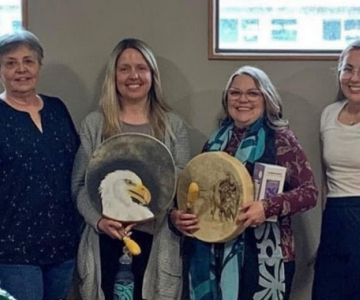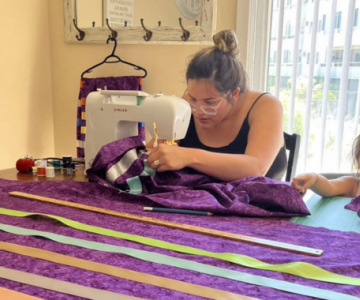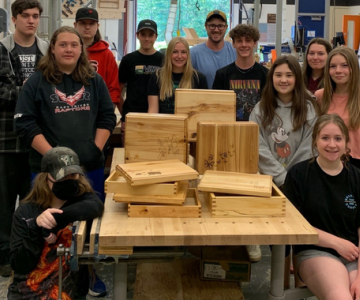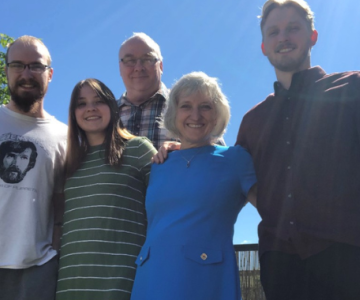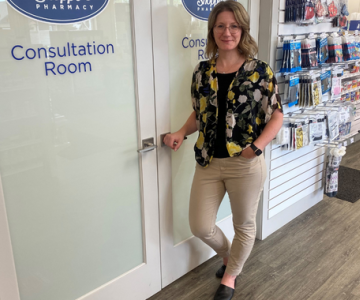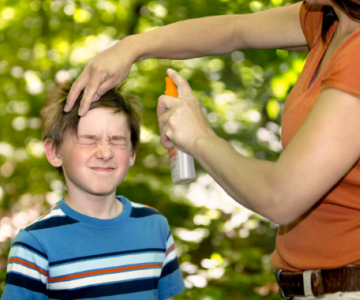Breadcrumb
Explore Stories
Community & Culture
Shawna Biron, far right, with colleagues (L-R) Debbie Whitehead, Shannon Statham and Terri Domin at a recent Ktunaxa Nation Letter of Understanding meeting.
Community & Culture
Sewing the symbolic ribbon skirts for Indigenous volunteers at this year's International Overdose Awareness Day events in Kelowna
Kori Smith is the mother of two young children, and expecting her third. Born in Portage la Prairie, Man., treaty to Long Plain First Nation, she is of Ojibwe and Cree ancestry. She now lives in Kelowna.
As a member of KANDU (Knowledging All Nations and Developing Unity) and a peer advisor for Interior Health’s mental health and substance use network, Kori understands the importance of International Overdose Awareness Day.
“August 31 is an important day for me because I have family who have overdosed in the past. One who has since passed away and the other who is still addicted to drugs,” says Kori. “It is a great way to spread awareness and be there for the ones we care about and love and to remind them that they are not forgotten.”
With support from the mental health and substance use network, Kori and her sister have sewn 10 purple ribbon skirts for Indigenous peer volunteers to wear for the Kelowna International Overdose Awareness Day events.
“I recently started ribbon skirt making by learning from my koko (grandma) Lorraine Daniels. She is a residential school survivor and is also the executive director of the National Residential School of Canada in Portage la Prairie, Man.,” explains Kori.
Community & Culture
Dr. Anders Ganstal enjoying his favourite winter activity - skiing
Name: Dr. Anders Ganstal (he/him/his)Job Title: Emergency Physician, Clinical Assistant Professor for UBC Department of Emergency Medicine, Regional Medical Director for the British Columbia Emergency Health Services (BCEHS) InteriorYears of Service: 17Worksite: Royal Inland HospitalCommunity: KamloopsAncestral Territory: Tk'emlúps te SecwépemcFavourite Quote/Advice to live by: Live for today, plan for tomorrow
With the ultimate goal of improving patient care, Dr. Anders Ganstal leverages his local and regional leadership roles to advance large-scale health-care initiatives. Referencing one of his favourite sports, Anders shares, “Quality improvement is similar to mountain biking. When you look up to the top from the bottom, it’s quite overwhelming. It’s one step at a time; that’s how you get to the top of the mountain.”
For this physician leader, it’s the contribution of every single person and each incremental step in the right direction that help push a change initiative forward.
Community & Culture
Senior woodworking students at Clearwater secondary participated in a project to build keepsakes for parents who lose babies at birth
A short lifetime of memories are attached to a project undertaken by Clearwater woodwork students last spring for grieving parents at Royal Inland Hospital.
For the students who carefully handcrafted the beautiful memory boxes, it taught knowledge and skills and also compassion in the face of deep sorrow.
For parents leaving the hospital with only memories of a baby, it provides a beautiful, engraved keepsake – a place to store tangible remembrances like photographs, clothing or tiny hand and foot prints.
Clearwater secondary school teacher Dayton Fraser was first approached about the woodworking project by a colleague whose daughter, Keira Geiger, was a nurse working on a preceptorship (practical experience and training) in the obstetrical unit (OB) at Royal Inland Hospital (RIH).
The idea was to build memory boxes and donate them to the hospital where they could be given to parents going home with only a broken heart.
Dayton, who is always on the lookout for projects that will engage students and teach them their craft, eagerly embraced the concept.
“It was a great project for our senior woodworking students. It got them on every machine from table saws to lasers for engraving and it gave them insight into life circumstances,” he said.
“It’s such a tragedy to lose a child and these students were really motivated to build a beautiful keepsake that these parents would be able to cherish forever.”
Fifteen students participated in the project and they did an “awesome job.” Each one is engraved with a butterfly and some other design, such as a baby toy or teddy bear.
Dayton said it took longer than anticipated and not every student completed their box, but those boxes will go into the inventory for next semester.
As the project progressed, Keira completed her preceptorship and Dayton remained in contact with the OB clinical practice lead, Val Kloska. In July, she was excited to get a call from him, saying he was ready to drop off the first instalment of the memory boxes.
When he arrived at the new labour and delivery unit in the Phil & Jennie Gaglardi Tower, he was met enthusiastically by Val and the labour and delivery team who understand just how much the boxes will mean to devastated parents.
“It was such an amazing project for both the school and the obstetrical unit,” said Teressa Allwood, clinical operations manager, maternal and child services. “These memory boxes will support our families during the hardest times of their lives.”
The project will continue during the next school year and be more streamlined.
“I’ve been able to fine-tune the process for next year. The first time I do a project, I’m learning the whole time,” said Dayton.
The project also epitomizes community, which is important for Dayton as a teacher.
The wood came from the property of a retired doctor, known in Clearwater as “Dr. Bob” (MacKenzie).
During COVID when students were not in school – with Dr. Bob’s consent – social studies teacher Sylvain Menard and Dayton took down the trees, which was on the path of the Trans Mountain pipeline. Dayton, metalwork and automotive teacher Bryn Leary, and retired woodworking teacher Brent Buck milled it with Brent’s portable sawmill.
Dayton views the memory box concept as reflective of the philosophy he learned from his predecessor, Brent.
“We teach our kids skills and knowledge, but what is the point if we are not using those skills and knowledge to give back to our communities?”
Community & Culture
Wanda (in the blue shirt) and her family
Name: Wanda Handschuh (she/her/hers)Job Title: Health Services for Community Living (HSCL) Nursing, Clinical Educator RNYears of Service: 30Worksite: Day-Break Adult Day CentreCommunity: VernonAncestral Territory: Syilx Okanagan / Okanagan Interior SalishAdvice to live by: “If you are going through hell, just keep going,” and “Normal is only a setting on a dryer.”
Wanda Handschuh has spent her entire life in British Columbia. Born in Dawson Creek, Wanda has also lived in Hudson Hope and Mica Creek, then Kamloops to complete school, study nursing and get married. After living in Revelstoke for a year with her husband, Darren (together for 34 years now), they moved to Vernon in 1991 and have never left.
Wanda enjoys supporting people with their health. Making people comfortable and sharing a laugh is important to her in her work. Currently a Clinical Educator in Health Services for Community Living (HSCL), Wanda enjoys meeting new people, and working with clients and their caregivers.
“Nursing has been a perfect fit for my personality and my passion. I look forward to continuing to learn about myself and others on this life journey.”
Health & Wellness
Jodi Cunningham, pharmacist and owner of Medicine Shoppe Vernon
It takes a team to combat one public health emergency – let alone two.
Pharmacist Justin Dovale and staff at Kelowna’s Two Nice Guys Pharmacy are part of that team.
The pharmacy opened in March 2021, in the middle of two public health emergencies. While people were being told to isolate due to COVID-19, many clients at risk of poisoning from the illicit drug supply needed Opioid Agonist Treatment or pharmaceutical alternative medications, which can require in-person appointments at a pharmacy.
Opioid Agonist Treatment, or OAT, is a first-line treatment for opioid use disorder. The medications, such as methadone, suboxone and kadian, are playing an important role in the response to the toxic drug crisis. Within Interior Health, the number of clients on OAT has risen from approximately 2,000 in 2015 to more than 4,000 in 2022.
“While we were telling people to isolate, drug dealers were delivering,” recalls Justin, adding he saw an opportunity to make a difference. “We started delivering OAT medications for those clients in isolation. Over time we have gotten to know the OAT providers and received many referrals. In a little over a year we’ve seen remarkable changes in terms of the quality of life for many of these folks.”
Justin says people are very motivated to make positive changes in their lives when they are on OAT.
“They don’t need to constantly worry about where they will get drugs. It allows them to focus on securing food and shelter. From there, people may pursue employment and safer, more permanent housing.”
Justin (front left) and team in front of his Two Nice Guys Pharmacy in Rutland, Kelowna
The fact that the pharmacists see OAT clients on a daily basis allows them to develop good relationships and a high degree of trust.
“We also do a lot of outreach and deliveries, so we are meeting people in their homes, meeting room-mates and families. People share their most intimate details, early traumas and how they became dependent on opioids,” Justin says.
Jodi Cunningham, pharmacist and owner of Medicine Shoppe Vernon, agrees.
Jodi and her team strive to be inclusive and supportive of everyone who walks through their door. Medicine Shoppe was the first pharmacy in the region to provide OAT delivery to shelters and supportive housing at the height of COVID-19.
When she was originally contacted by Interior Health about delivery of OAT medications, Jodi realized she had a chance to make a difference for people who face tremendous barriers and often insurmountable stigma.
“Delivery has enabled access for patients who otherwise struggle to remain on treatment,” she says, adding that there are stringent rules around the medications, to the point that it can be a deterrent for some pharmacists to handle the treatment option.
“But access to OAT and harm reduction medications is crucial for clients to be successfully maintained on treatment and have an opportunity to pursue stability in other areas of their life once they are not reliant on the toxic drug supply,” she says. “Many people do not appreciate what these clients are up against. The barriers are much more than most people see or comprehend. Because we’ve done the outreach and delivery piece, we see the consequences of the toxic drug supply first hand.
“We know if we don’t go over and above to ensure they have the medications they need, and at therapeutic doses, we are further endangering them when we have the ability to help keep them safe. We owe them better than that. If they are missing doses we need to work with patients and clinicians to find out why and how we can support them. That’s our responsibility.”
Jodi says it’s incredibly gratifying to see people become stable and succeed on OAT. Provision of medications is really only a small part of the role pharmacists can have; support, education and encouragement can make a significant difference in patient outcomes.
“We have seen patients once unable to maintain housing become stably housed, gainfully employed and also volunteering to give back to peers and the community. It’s been very rewarding.”
Learn more about OAT
Community & Culture
Celeste hiking at Idaho Peak in Sandon, B.C.
Name: Celeste Hein (she/her/hers)Job Title: Patient Ambassador and Support WorkerYears of Service: 11Worksite: Boundary District HospitalCommunity: Grand ForksAncestral Territory: Syilx – Okanagan Interior Salish
Celeste Hein was born and raised in Grand Forks, B.C., where she has been working as a Patient Ambassador and Support Worker at the Boundary District Hospital for 11 years. As an adventurous, outdoorsy person, she lives by the adage, “At the end of the day, your hair should be messy, your feet dirty and your eyes sparkling.”
Health & Wellness
Did you know that young children ages six months to 5 years are now able to be vaccinated against COVID-19? Here’s what parents and guardians need to know:
Health & Wellness
People receive a lot of UV exposure and attention from mosquitoes during the summer. Sunscreen and bug repellent serve as effective layers of protection but it’s important to ensure you’re using them properly to maximize that protection. This post contains helpful tips from HealthLink BC.
-
Load More
Showing 423 of 786
Sign up for email updates
Receive news, alerts, public service announcements and articles right to your inbox.


